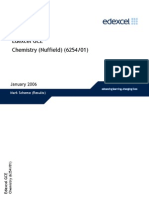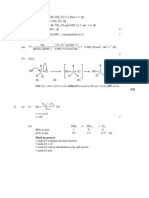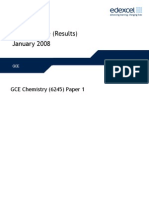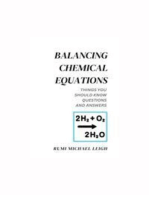6254 01 Rms 20060616
6254 01 Rms 20060616
Uploaded by
Iqbal WahyuCopyright:
Available Formats
6254 01 Rms 20060616
6254 01 Rms 20060616
Uploaded by
Iqbal WahyuOriginal Description:
Original Title
Copyright
Available Formats
Share this document
Did you find this document useful?
Is this content inappropriate?
Copyright:
Available Formats
6254 01 Rms 20060616
6254 01 Rms 20060616
Uploaded by
Iqbal WahyuCopyright:
Available Formats
Edexcel GCE
Chemistry (Nuffield)
6254/01
Results Mark Scheme
June 2006
E
d
e
x
c
e
l
G
C
E
C
h
e
m
i
s
t
r
y
(
N
u
f
f
i
e
l
d
)
6
2
5
4
/
0
1
2
3
1 (a) Any 2
Measure the loss in mass as a gas/carbon dioxide is given off (1)
Measure the concentration of the acid by titration
OR Carry out a titration with sodium hydroxide (1)
NOT titration on its own
Measure conductivity because 4 ions go to 3 ions/decrease in
ions/change in number of ions (1)
Measure pH because acid is used up /changes/concentration
changes/one reactant is acidic (1)
NOT dilatometry/nmr/x-ray crystallography/temperature
change/colorimetry/indicator/change in mass of CaCO
3
(2 marks)
(b) Initially some carbon dioxide dissolves in the solution (until the solution
is saturated).
OR
Some CO
2
might escape whilst adding acid/before putting on bung
(1 mark)
(c) (i) 88 (cm
3
)
(1 mark)
(ii) 95 72 16
125 79 9
155 84 4
185 87 1
(1 mark)
(iii) The concentration of the hydrochloric acid/HCl
OR [HCl]
NOT concentration of reactants
(1 mark)
4
(iv)
points correctly plotted (1)
ALLOW TE for points
and reasonably smooth curve drawn (1)
NOT dot-to-dot
(2 marks)
(v) three successive half-lives shown on the graph (1)
MUST start at defined volume NOT 0s/85cm
3
all three values similar about 37s (1)
ALLOW 32-42 or show on graph
NOT 40, 80, 120
constant half-life / half-life not increasing means first order
reaction (1)
If only two half lives shown max 2
If in (v) zero/2
nd
order deduced max 1 for first part but TE
allowed to parts (vi) and (vii)
(3 marks)
(vi) rate = k[HCl]
OR rate =k[HCl]
1
OR rate =K[HCl]
1
[CaCO
3
]
0
NOT rate = k[V
final
-V
t
]
1
If zero order
rate = k
OR rate = k[HCl]
0
If second order
rate = k [HCl]
2
NOT rate = k[CaCO
3
]
1
[HCl]
1
(1 mark)
(vii) s
-1
T.E
zero order mol dm
-3
s
-1
second order dm
3
mol
-1
s
-1
(1 mark)
ALLOW extrapolated back
to between 88 and 100
5
(d) S
system
positive + some sensible reason eg gas given off (1)
as a mole of a gas given off and three moles including one solid becomes
three moles with no solid / gas more random than solid
OR
Gas more disordered than a solid
OR
Despite same number of moles/particles (1)
S
total
positive + some reason (1)
e.g.
positive because reaction exothermic/favourable (1)
positive + good reason (2)
e.g
positive because reaction is spontaneous/goes to completion /feasible
OR S
surroundings
is positive because H is negative/reaction exothermic
S
total
positive (2)
[provided S
system
shown positive earlier]
(4 marks)
TOTAL 17 MARKS
6
2 (a) sodium ethanoate (1)
NOT sodium methanoate
NOT sodium ethoxide
neutralisation / acid-base (1)
If more than one answer given and one is incorrect (0)
e.g. substitution neutralisation (0)
(2 marks)
(b) 4-iodomethoxybenzene / 4-methoxyiodobenzene (1)
ALLOW 4-iodo-1-methoxybenzene
ALLOW 4-methoxy-1-iodobenzene
NOT 4-iodine..
NOT 4-iodide.
Electrophilic/electrophile (1)
ALLOW reasonable spelling e.g. electrophyllic
ALLOW correct diagram showing mechanism
e.g.
+
I Cl
Attacking benzene ring
(2 marks)
(c) ethanamide (1)
ALLOW ethaneamide
nucleophilic/nucleophile (1)
IGNORE if S
N
1/S
N
2 included but NOT S
N
1 on its own nor S
N
2 on its
own
(2 marks)
(d) Propan(e)(-)1,2,3(-)triol / glycerol (1)
ALLOW glycerine
ALLOW 1,2,3-propan(e)triol
NOT prop 1,2,3-triol
NOT propan-1,2,3-ol
Decanoic acid (1)
Hydrolysis/hydrolysation (1)
NOT condensation/hydration
(3 marks)
Total 9 marks
7
3 (a) (i) arene /high C:H ratio/high C-H ratio/contain a benzene ring
/low H:C ratio
NOT alkene
NOT unsaturated
(1 mark)
(ii) aldehyde or ketone / carbonyl group
ALLOW C=O
NOT double bonded oxygen
(1 mark)
(iii) aldehyde
If in (ii) aldehyde or ketone given, then ALLOW not ketone
in (iii)
NOT can be oxidised
(1 mark)
(iv) alkene / activated arene
ALLOW contains a carbon-carbon double bond/unsaturated
NOT enhanced arene/delocalised electrons/has a double
bond/benzene
(1 mark)
(v) contains the same two groups/atoms on the same side (of a
double bond) /OWTTE
NOT trans isomer as well
[The mark for (iv) might be seen here!]
(1 mark)
(vi) Need not be displayed
H
C
H
C
H
C O
Benzene ring and cis alkene (1) if whole molecule is C
9
H
8
O
aldehyde (1) aldehyde anywhere if whole molecule is C
9
H
8
O
(2 marks)
8
(b) (i) Any 5
Dissolve in the minimum volume (1)
of boiling/hot water (1)
Filter to remove insoluble impurities (1)
Cool to precipitate benzoic acid (1)
Filter off precipitate to leave impurities in solution (1)
Wash with (cold) solvent/water (to remove any remaining
soluble impurities) (1)
dry between pieces of filter paper (to remove water/solvent)
(1)
If dissolve in boiling water, cool and filter 2 max
If method will not work 3 max
(5 marks)
(ii) a sharp melting point
OR mpt same as data book
MUST compare with data book value
NOT measure melting point on its own
(1 mark)
(c) (i) 2C
6
H
5
CO
2
H(s) + Na
2
CO
3
(aq) 2C
6
H
5
CO
2
Na (aq) + H
2
O(l) + CO
2
(g)
H
2
CO
3
(aq)
Formula and balancing (1)
State symbols (1)
All five state symbols must be correct and products must have
correct formulae but not necessarily balanced or just a slip in
formula
If NaCO
3
then if ALL state symbols are correct and formulae of
products correct 1 max
If NaHCO
3
as the product max 2
(2 marks)
9
(ii)
C
6
H
5
CO
2
H / C
6
H
5
CO
2
+ H
+
(1)
[C
6
H
5
CO
2
] x [H
+
]
K
a
= [C
6
H
5
CO
2
H] (1)
State symbols not required
ALLOW H
3
O
+
in equation and K
a
expression
(2 marks)
(iii)
K
a
= 6.30 x 10
-5
= [H
+
(aq)]
2
(1)
0.001
[H
+
]
2
= 6.30 x 10
-8
[H
+
] = 2.51 x 10
-4
(1) ALLOW TE if incorrect [H
+
]
pH = 3.6/3.60/3.600 (1) but correctly applied
pH = -log[H
+
]
Correct answer with no working (3)
(3 marks)
(d) sodium / potassium benzoate
OR formula
NOT sodium hydroxide
NOT sodium carbonate
NOT sodium benzonate, sodium benzenoate, sodium ethanoate
NOT C
6
H
5
CO
2
If correct name given ignore partly drawn structures
e.g.
OR C
6
H
5
CO
2
(1 mark)
10
4 (a) pentyl dichloroethanoate (1)
ALLOW 1,1 OR 2,2-
ALLOW pent-1-yl /all one word
NOT penten
NOT pentan
NOT pentanyl
ester (1)
ALLOW esther
(2 marks)
(b) (i) using a pipette remove a known volume (say 20 cm
3
) (1)
remove some solution either with a pipette
OR a known volume/ 20 cm
3
titrate with an alkali (such as sodium hydroxide) (1)
of known concentration (1) dependent on previous mark ie must
have mentioned alkali
IGNORE quenching
using a named indicator eg. phenolphthalein/methyl orange (1)
NOT litmus/universal indicator
Measure pH on its own 1 (out of 4)
But if calculation fully explained from pH can get full marks
(4 marks)
(ii) [CHCl
2
COOC
5
H
11
(l)]
K
c
= [CHCl
2
COOH(l)] x [C
5
H
10
(l)]
State symbols not required
(1 mark)
(iii) C
5
H
10
1.7 (1) 1.7 = 5.67(5.7) NOT 5.66
0.3
(1) for moles at eq
CHCl
2
COOC
5
H
11
0.6 (1) 0.6 = 2 by 0.3 in both cases
0.3
(3 marks)
11
(iv)
K
c
= 0.6 / 0.3 x 1.7 / 0.3 (1) =
67 . 5 33 . 1
2
1.33
= 0.265 (1) dm
3
mol
-1
/ mol
-1
dm
3
(1)
NOT dm
-3
ALLOW 0.27/0.26/0.264
Penalise 1 SF or 4SF or more SF but only take off 1 mark maximum in
(iii) and (iv) for significant figure errors
ALLOW TE from expression in (ii)
TE using numbers for (iii) full marks possible
(3 marks)
TOTAL 13 MARKS
Total for paper: 60 Marks
You might also like
- 2007 January Chemistry Paper 5 Edexcel A2Document16 pages2007 January Chemistry Paper 5 Edexcel A2waseemNo ratings yet
- Advanced Placement Chemistry: 1991 Free Response QuestionsDocument15 pagesAdvanced Placement Chemistry: 1991 Free Response QuestionsManasNo ratings yet
- 4.5 4.7 Equilibria and Acids and Bases MSDocument70 pages4.5 4.7 Equilibria and Acids and Bases MSABFauzyNo ratings yet
- Acid-Base Mark Scheme 3Document8 pagesAcid-Base Mark Scheme 3Jake RobinsonNo ratings yet
- Unit 4 2006 Jan MSDocument11 pagesUnit 4 2006 Jan MSraaaaaawrNo ratings yet
- 6243 02 Rms 20060125Document7 pages6243 02 Rms 20060125UncleBulgariaNo ratings yet
- 6242 01 Rms 20060616Document10 pages6242 01 Rms 20060616UncleBulgariaNo ratings yet
- 6254 01 Rms 20060125Document11 pages6254 01 Rms 20060125chemking79No ratings yet
- Chemistry Nov 06 Mark SchemeDocument3 pagesChemistry Nov 06 Mark SchemePhooleeNo ratings yet
- Chemistry 6243/02: Edexcel GCEDocument8 pagesChemistry 6243/02: Edexcel GCELara AndrewNo ratings yet
- Mark Scheme (Results) January 2007: GCE Chemistry (6243/02)Document12 pagesMark Scheme (Results) January 2007: GCE Chemistry (6243/02)Lara AndrewNo ratings yet
- 4.10 - 4.11 Organic Synthesis and Structure Determination MSDocument30 pages4.10 - 4.11 Organic Synthesis and Structure Determination MSAdnan ChowdhuryNo ratings yet
- EdExcel A Level Chemistry Unit 4 Mark Scheme Results Paper 1 Jun 2005Document10 pagesEdExcel A Level Chemistry Unit 4 Mark Scheme Results Paper 1 Jun 2005MashiatUddinNo ratings yet
- Acids, Bases and Buffers HW MsDocument4 pagesAcids, Bases and Buffers HW Msc7uptNo ratings yet
- Chem Unit 5 Quantitative AnswersDocument14 pagesChem Unit 5 Quantitative Answersareyouthere92No ratings yet
- Chem 2 - Organic ADocument59 pagesChem 2 - Organic Aareyouthere92No ratings yet
- 9701 s10 Ms 42Document9 pages9701 s10 Ms 42Sheng Qian YewNo ratings yet
- Unit 5 Exam Questions MSDocument201 pagesUnit 5 Exam Questions MSTahirNo ratings yet
- Chem Unit 5 Organic AnswersDocument47 pagesChem Unit 5 Organic Answersareyouthere92No ratings yet
- Mark Scheme (Results) January 2007: GCE Chemistry (6244/01)Document23 pagesMark Scheme (Results) January 2007: GCE Chemistry (6244/01)raaaaaawrNo ratings yet
- 199706Document9 pages199706Will LeiNo ratings yet
- Chem Unit 5 Inorganic AnswersDocument13 pagesChem Unit 5 Inorganic Answersareyouthere92No ratings yet
- Analytical Chemistry AQA AnswersDocument30 pagesAnalytical Chemistry AQA AnswersAhmad BustamiNo ratings yet
- Paper 4 Nov 2004Document5 pagesPaper 4 Nov 2004MSHNo ratings yet
- Alcohol AnswersDocument6 pagesAlcohol Answerslucylovesbooks6770No ratings yet
- 6241 01 Rms 20050618Document10 pages6241 01 Rms 20050618UncleBulgariaNo ratings yet
- Paper 2 Marking Scheme 2013Document18 pagesPaper 2 Marking Scheme 2013Jaaizah JaafarNo ratings yet
- 2006 Final Mark SchemeDocument7 pages2006 Final Mark SchemeEugenia MigranovaNo ratings yet
- Edexcel GCE Chemistry (6245/01) : J Anuary 2006Document10 pagesEdexcel GCE Chemistry (6245/01) : J Anuary 2006granadeclamoNo ratings yet
- Chemistry 2 - Exam n Answers - Msomibora.com (2)Document23 pagesChemistry 2 - Exam n Answers - Msomibora.com (2)philemonaroko006No ratings yet
- Module 5 MS PDFDocument17 pagesModule 5 MS PDFSigourney MarshNo ratings yet
- Equation Name of Mechanism Mechanism: 4.8, 4.9 Exam Questions Ms 1Document9 pagesEquation Name of Mechanism Mechanism: 4.8, 4.9 Exam Questions Ms 1Adnan ChowdhuryNo ratings yet
- F325 Exam and Synoptic Questions Answers (Student Copy)Document28 pagesF325 Exam and Synoptic Questions Answers (Student Copy)Sam999strNo ratings yet
- Uk Chemistry Olympiad Round 1 Mark Scheme 2017Document13 pagesUk Chemistry Olympiad Round 1 Mark Scheme 2017JackieWilson100% (1)
- Unit 4 Rate of Reaction AnswersDocument38 pagesUnit 4 Rate of Reaction Answersareyouthere92No ratings yet
- F325 Acids, Bases and Buffers Test MsDocument3 pagesF325 Acids, Bases and Buffers Test MsSigourney MarshNo ratings yet
- 2.5 Group II All ExamWizard Questions Mark SchemeDocument12 pages2.5 Group II All ExamWizard Questions Mark SchemeAmber MichaelsNo ratings yet
- Mark Scheme (Results) January 2008: GCE Chemistry (6245) Paper 1Document11 pagesMark Scheme (Results) January 2008: GCE Chemistry (6245) Paper 1eeshvariNo ratings yet
- 4.03 Acid and Bases MSDocument24 pages4.03 Acid and Bases MSAdnan ChowdhuryNo ratings yet
- Pyramidal: Not Number of Electrons' or Number of Protons in An Element'Document67 pagesPyramidal: Not Number of Electrons' or Number of Protons in An Element'Darly SivanathanNo ratings yet
- Markscheme Unit5 (6CH05) January2011Document15 pagesMarkscheme Unit5 (6CH05) January2011Vraj PatelNo ratings yet
- Electrode_Potentials_and_Electrochemical_Cells_Mini_test_MSDocument3 pagesElectrode_Potentials_and_Electrochemical_Cells_Mini_test_MS18alij.psNo ratings yet
- Mark Scheme (Results) January 2007: GCE Chemistry (6244/01)Document23 pagesMark Scheme (Results) January 2007: GCE Chemistry (6244/01)Ajmaeen Mahtab GalibNo ratings yet
- Group2 and 7 AnswersDocument44 pagesGroup2 and 7 Answers123456No ratings yet
- IGCSE Chemistry 4335 2H Mark Scheme (Results) Summer 2008Document10 pagesIGCSE Chemistry 4335 2H Mark Scheme (Results) Summer 2008gkawsar22No ratings yet
- 2013 Chemistry Solutions enDocument11 pages2013 Chemistry Solutions envaliaNo ratings yet
- 9701 s07 Ms 4Document8 pages9701 s07 Ms 4Vivian SiewNo ratings yet
- Code: Name:: Total Scores: 38 Points Total Points 4 4 4 4 6 4 8 4 38 ReceivedDocument24 pagesCode: Name:: Total Scores: 38 Points Total Points 4 4 4 4 6 4 8 4 38 ReceivedMacxsimusNo ratings yet
- A Level Chemistry Paper 1 Set 18 Marking GuideDocument11 pagesA Level Chemistry Paper 1 Set 18 Marking GuideSsenono AndrewNo ratings yet
- 1.6 Database MsDocument10 pages1.6 Database MsbebsybiswezNo ratings yet
- 1993 Free Response Answers: Return To Questions Return To Additional Materials MenuDocument10 pages1993 Free Response Answers: Return To Questions Return To Additional Materials MenuNightNo ratings yet
- Mark Scheme: Chemistry 6821Document13 pagesMark Scheme: Chemistry 6821Quach Pham Thuy TrangNo ratings yet
- Gas Hydrates 1: Fundamentals, Characterization and ModelingFrom EverandGas Hydrates 1: Fundamentals, Characterization and ModelingDaniel BrosetaNo ratings yet
- NEET National Eligibility Cum Entrance Test Chemistry Class 11 + 12 Volume I + Volume IIFrom EverandNEET National Eligibility Cum Entrance Test Chemistry Class 11 + 12 Volume I + Volume IINo ratings yet
- Graphene Oxide: Fundamentals and ApplicationsFrom EverandGraphene Oxide: Fundamentals and ApplicationsAyrat M. DimievNo ratings yet
- Balancing Chemical Equations: Things You Should Know (Questions and Answers)From EverandBalancing Chemical Equations: Things You Should Know (Questions and Answers)No ratings yet
- Practice Makes Perfect in Chemistry: Oxidation-ReductionFrom EverandPractice Makes Perfect in Chemistry: Oxidation-ReductionRating: 5 out of 5 stars5/5 (1)
- Avicenna: Vision 2015Document5 pagesAvicenna: Vision 2015Iqbal WahyuNo ratings yet
- Akismun Society 2014-2015: Welcome MunersDocument5 pagesAkismun Society 2014-2015: Welcome MunersIqbal WahyuNo ratings yet
- Kinetics Independent HW MSDocument3 pagesKinetics Independent HW MSIqbal WahyuNo ratings yet
- Independent Notes Plant TransportDocument3 pagesIndependent Notes Plant TransportIqbal WahyuNo ratings yet
- Is Rubisco The Most Important Enzyme in The WorldDocument2 pagesIs Rubisco The Most Important Enzyme in The WorldIqbal WahyuNo ratings yet
- Post Secondary Education in SingaporeDocument6 pagesPost Secondary Education in SingaporeIqbal WahyuNo ratings yet

































































